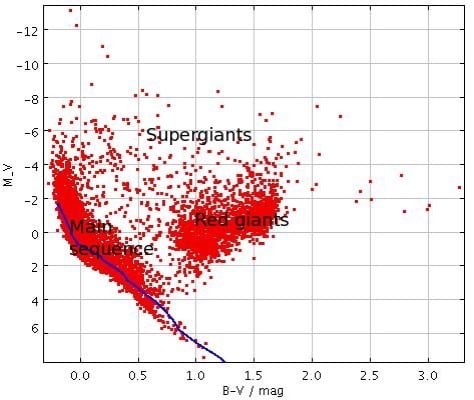user99379 on physics.stackexchange.com asks “Of the stars that can be seen with the naked eye, what are the distributions of each type? For example, how many are main sequence? how many are Super Red giants/white dwarfs/neutron stars…etc. What’s the distribution by mass and distance?”
Most of the brightest stars are nearby main sequence stars with spectral types B, A and F (50%, e.g. Sirius, Altair, Vega), but there are also a bunch of more distant O-type main sequence and giant stars (5%, e.g. Regor, Naos) and another big clump of red giants (about 35%, e.g. Arcturus, Aldebaran) and a few percent are distant supergiants (e.g. Deneb, Rigel, Betelgeuse). There are no white dwarfs, and definitely no neutron stars!
I have attached an image which I created by selecting 4992 bright (V 6, hence visible from a good site) stars from the new, revised, Hipparcos catalogue (van Leeuwen 2007) with a parallax and plotted them on the absolute V vs B-V colour-magnitude diagram (analogous to the Hertzsprung-Russell diagram). Also shown is a zero age main sequence for stars
- SEO Powered Content & PR Distribution. Get Amplified Today.
- PlatoData.Network Vertical Generative Ai. Empower Yourself. Access Here.
- PlatoAiStream. Web3 Intelligence. Knowledge Amplified. Access Here.
- PlatoESG. Automotive / EVs, Carbon, CleanTech, Energy, Environment, Solar, Waste Management. Access Here.
- BlockOffsets. Modernizing Environmental Offset Ownership. Access Here.
- Source: https://blog.adafruit.com/2023/07/01/what-are-the-demographics-of-stars-visible-to-the-naked-eye/




